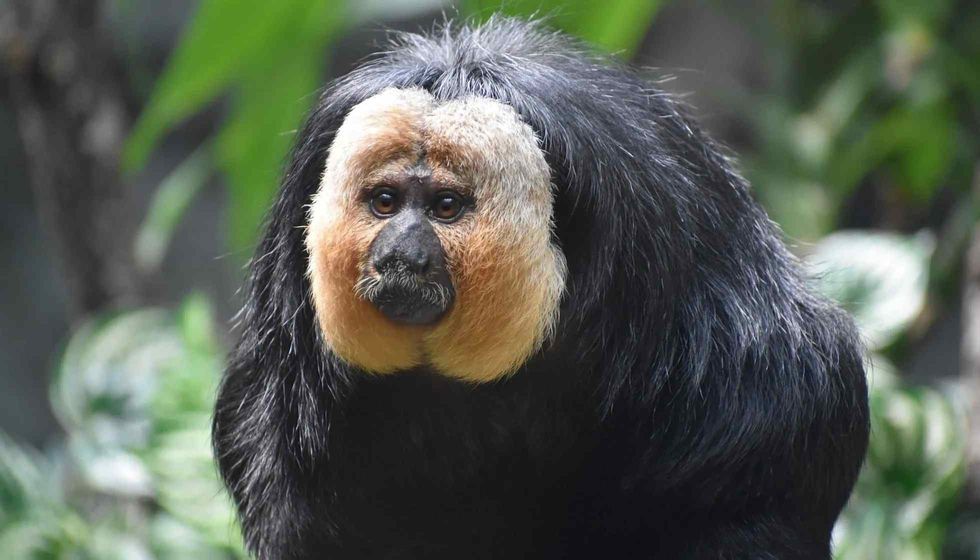Saki monkeys, also called Pithecia pithecia, are small primates found in various parts of South America. The male sakis of Brazil have a uniformly dark body with a contrasting pale face.
There are also white-faced saki monkeys, with cream-yellow faces or white faces. The female sakis are gray and brown all over.
Ironically, it is the female sakis who are called bearded saki monkeys, as their throats are covered in fur. On the other hand, the throats are bare in the male sakis so they can easily smell out female sakis during the breeding season.
The conventional and white-faced saki monkeys live upon the trees within rainforests. The species rarely come down due to the fear of predators.
They survive happily munching on a diet of fruit, flowers, seeds, leaves, and insects. They are also playfully referred to as the flying monkey, due to their ability to leap from one tree to another at a rapid pace.
They can cover a sizable distance of 33 ft (10 m), which is almost 10 times the total length of this primate!
While the official conservation status is Least Concern, care should always be taken by humans for the conservation of their habitat. Else the day is not far away when these monkeys will no longer be classified as Least Concern conservation status and face the potential threat of extinction!
Read on for more interesting white-faced saki monkey facts. You may also check out pygmy slow loris facts and aye-aye facts from Kidadl.
Saki Monkey Interesting Facts
What type of animal is a saki monkey?
Saki (pronounced sah-kee) monkeys are a type of primate animal.
What class of animal does a saki monkey belong to?
Saki monkeys belong to the class Mammalia.
How many saki monkeys are there in the world?
While the exact count of saki monkeys (Pithecia pithecia) is unknown, there are five different species identified (including species of New World monkeys).
Where does a saki monkey live?
Saki monkeys (Pithecia pithecia) live in tropical rainforests, which are closest to providing them their food sources in abundance. These monkeys live in trees and very rarely get down on the ground. The animal is also kept in the zoo. White-faced sakis live in Brazil, Venezuela, Guyana, Suriname, and French Guiana.
What is a saki monkey's habitat?
Saki monkeys have a diurnal habitat. This means that they are wildly active during the day, jumping across trees in search of food.
They are also blissfully asleep at night, unlike nocturnal predators. They come down to the ground only in rare cases. Even to drink water, their first source is to pick from water puddles within the tree itself.
They will hunt down a ground-based water source (like a mud pond or a river in the forest), only when there is no water available on the top. For this, they will quickly climb down to the water source, fill their hands with water, and rush back to safety in very little time.
Who do saki monkeys live with?
Saki monkeys are natives of South America and live together in small groups of 4-10 monkeys. They mate within these groups, although some monkeys are known to be monogamous with just one partner all their life.
They are very cautious with strangers. This includes other saki monkeys outside their groups.
Ironically, male sakis in this species are not very possessive about their own infants in groups. It is entirely up to the female bearded saki monkey species to protect and care for the younger ones. This is especially seen in the forests and zoos of Brazil, South America.
How long does a saki monkey live?
Saki monkeys typically live for 15 years when they are in the wild. But in a zoo, they are known to live up to 35 years.
How do they reproduce?
The males and females have distinctive physical attributes for identification. The male sakis of South America have a pale face and a bald throat, which is ideal for smelling out a mate during the breeding season.
This is typically from November to December, but they can mate all through the year. The female sakis have a darker face and fur on their throat.
Both specimens achieve physical maturity when they are about three years old. The males call out to the females through shrill whistles, gestures, and chuckles. Oh yes, they are quite vocal about their interest in a female!
Once they mate, the females carry the infants through a gestation period of 146 days. They also continue to care for the young ones even after birth. In fact, infants are commonly seen holding on to their mother’s necks until they are five to six months old.
What is their conservation status?
While the official conservation status is Least Concern, care should always be taken by humans for the conservation of their habitat. Else the day is not far away when these monkeys will no longer be classified as Least Concern conservation status and face the potential threat of extinction!
Saki Monkey Fun Facts
What do saki monkeys look like?

Male saki monkeys are black with a white or reddish head. Female saki monkeys are brown or brown and gray with bellies that are pale. They also have white or red stripes extending from their eyes to the corner of the mouth.
How cute are they?
They are adorably cute when they are safe up in the trees. But if they feel threatened, they can resort to violent behavior.
How do they communicate?
They communicate with a combination of sounds (shrill whistles and chuckles), hand gestures, and scents.
How big is a saki monkey?
They are small monkeys, less than half the size of a cat.
How fast can a saki monkey move?
Saki monkeys can move with amazing speed. It is this attribute that gives them their nickname, flying monkey, due to their ability to cover as much as 120 ft (10 m) in one massive jump!
How much does a saki monkey weigh?
They weigh between 2-5 lb (1-2 kg).
What are the male and female names of the species?
Both males and females are simply called saki monkeys, also referred to by their scientific name Pithecia pithecia.
What would you call a baby saki monkey?
Baby saki monkeys are called infants, much like humans! Again, they may also be referred to by their scientific name Pithecia pithecia.
What do they eat?
Living up in the trees in lush rainforests, saki monkeys are blissfully happy munching on a bunch of fruit, seeds, leaves, and flowers. For this, they have sharp incisor teeth to cut through the tough shells of many fruit and seeds. They also eat insects sometimes.
Saki monkeys are preyed on by many predators of the jungle, including large eagles, jaguars, and snakes.
Are they loud?
Oh yes, they are! This is most visible during the breeding season, more so from November to January. They make very loud calls to their mates to catch their attention through shrill whistles and chuckles. They can also get aggressively loud when they perceive a threat, especially from a stranger saki species, or even a predator.
Would they make a good pet?
Saki monkeys depend on the dynamics within their group and with their (often monogamous) pair to survive. If these can be replicated by humans, they can live happily, and for longer (up to 35 years in a zoo).
Did you know...
The face is a distinctive physical attribute in this species and gives the Brazil saki its name. The white-faced saki monkeys obviously have white faces, while the bearded saki monkeys refer to the female’s fur-covered throat.
There is also the Miller saki monkey, a type of New World primate with coarse hair. This species is found in various parts of South America.
How to draw a saki monkey
Brazil sakis are small primates. Each has a round head, a lean body, long, bushy tail that is equal in length to the rest of its body. It has two hands and two legs just like humans but walks on all of its hands and legs.
To draw a white face saki monkey is easy. Here are steps to draw this playful primate from Brazil:
Begin with a mid-sized ellipse in the center of your page. This will be the snout, housing both its nose and mouth. Draw a small mini ellipse on top for its snout, and a wide, happy smile at the bottom for its mouth.
Now the white-faced saki needs a head full of hair. Draw a circle shape above the head. Within this, draw the biggest M you can fit within its head.
This new world monkey needs a good-sized body. So, draw a longish, circle below its snout.
Give this saki a heart by drawing a smaller circle within its body.
Give its body two hands on top and two legs from the bottom.
No saki is complete without its tail. So draw this tail from the bottom of its body.
Different types of saki monkeys
The conventional saki monkeys have a dark fur tone. Males are blackish in color, while females are brown/gray. Males also have pale-colored faces, while females retain the dark color even on their faces.
There is also the white-faced saki monkey, characterized by a cream-yellow colored face. White-faced sakis have similar attributes and habitats to conventional sakis.
The Miller saki monkey is a New World primate, more commonly found in Columbia, Peru.
Here at Kidadl, we have carefully created lots of interesting family-friendly animal facts for everyone to discover! Learn more about some other mammals from our mangabey facts and black lemur facts pages.
You can even occupy yourself at home by coloring in one of our free printable brown saki monkey coloring pages.









